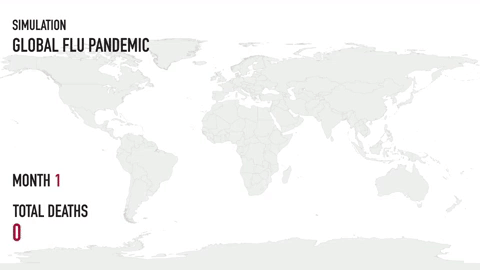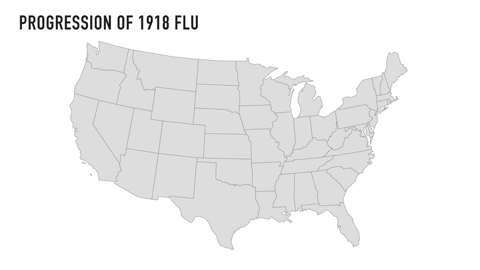What Bill Gates Fears Most

Jose Luis Magana/AP
The threat of a flu pandemic clouds even his legendary optimism, so he's launching an initiative to prevent one.
Bill Gates fancies himself an optimist. Global health, he feels, is on an upward trajectory. Childhood deaths are plummeting. Polio is on the verge of eradication.
But if there’s one issue that punctures his positivity, it’s the possibility that the world will face a serious pandemic—and the near certainty that we aren’t prepared for it.
“This is a rare case of me being the bearer of bad news,” he says. “My general narrative is: Hey, we’re making great progress and we just need to accelerate it. Here, I’m bringing more of: Hey, you thought this was bad? [You should] really feel bad.”
In 2015, Gates said at the TED conference that “if anything kills over 10 million people in the next few decades, it’s most likely to be a highly infectious virus.” Three years later, he stands by that assessment. “It would take a heck of a meteor or volcano or earthquake to get you to 10 million,” he tells me. “Even a nuclear weapon going off in New York City wouldn’t be 10 million.” By contrast, in 1918, when an H1N1 flu virus swept the world, it killed between 50 and 100 million people, and slashed U.S. life expectancy by 12 years.
Medicine has advanced considerably since then, but those advances are spread thinly (as this year’s non-pandemic flu season showed), and they depend on convoluted and precarious supply chains. The world is far more populated than in 1918—7.6 billion people today versus around 2 billion then—as well as more densely populated. Based on that, the Institute of Disease Modeling predicts that a severe flu pandemic could kill more than 33 million people in just 250 days. Several concerning strains are already circulating.

To help prepare the world for the next pandemic, the Bill and Melinda Gates Foundation, together with Alphabet’s Larry Page and his family, are launching a $12 million grand challenge to spur research into a universal flu vaccine—one that will be effective against all strains of this frustratingly diverse virus. Gates announced the new initiative at the Shattuck Lecture in Boston on Friday, on the centennial of the 1918 flu.
Vaccines against measles, mumps, or rubella provide lifelong protection. But the flu comes in a large number of subtypes—H1N1, H5N1, H7N9, and so on—and many strains within those. The viruses also change constantly, which is why the flu vaccine must be constantly updated to target the strains that are most likely to cause problems next. A universal vaccine, which would protect against all possible subtypes and strains, would change that. It would effectively take flu off the table as a major threat, protecting people against future pandemics, while reducing the need for annual vaccination campaigns.
“If you could get rid of flu, then you wouldn’t have this yearly exercise of trying to guess which strain,” says Gates.
Others are on the same page: Tony Fauci, the director of the National Institutes for Allergies and Infectious Diseases, recently unveiled a strategic plan for creating a universal vaccine. The new Gates/Page grand challenge is designed to shake things up even further. It’s specifically looking to fund completely new and unconventional approaches that differ from those already in development, projects that draw in people who don’t normally work on flu, and ideas that will bridge the “valley of death” that stops pharmaceutical companies from investing in otherwise promising technologies.

Teams of researchers are invited to apply for two-year pilot grants of up to $2 million, and the most promising of these will get to apply for a bigger $10 million pot. The goal is to get potential universal vaccines into clinical trials by 2021.
I ask Gates if that’s realistic. Despite years of research, scientists haven’t even developed a vaccine that’s effective against, say, all strains of H1N1, let alone all strains, full stop. “Sometimes I’m over-optimistic,” he admits. “There’s no guarantee we’d have one in 10 years, but I think there’s a reasonable chance that we will.” And he adds that some of the strategies being pursued, like targeting vaccines to the most stable parts of the flu virus, will also be useful for designing vaccines against other adaptable pathogens like HIV. “The world is waiting for a lot of very important vaccines,” he says.
For that reason, Gates is encouraged by the creation of the Coalition for Epidemic Preparedness Innovations, or cepi. A partnership between several governments and nonprofits, including the Gates Foundation, cepi is funding the development of vaccines against Lassa fever, mers, and Nipah. All three diseases can cause serious epidemics, but since they are rare and tend to hit poor countries, pharmaceutical companies have little incentive to make the huge investment necessary to develop vaccines. “There really is no private-sector business model for epidemic preparedness,” Gates says. Cepi, like the new flu grand challenge, bridges that gap. “It’s kind of weird that the world waited so long to do that,” he adds.
Ultimately, Gates thinks that the private sector cannot prepare the world for future epidemics and pandemics on its own. “It’s not like the Gates Foundation is going to own planes or a vaccine factory,” he says. Preparedness depends on “government funding, overwhelmingly.” And such funding must be stable, he argues, rather than rising during each new outbreak and falling once the crisis recedes into memory. “It’s very similar to being, you know, prepared for war,” says Gates.
Despite Gates’s concerns, there are many signs of his trademark optimism in his Boston lecture. He notes that researchers have developed diagnostic tests that exploit the gene-editing technique known as crispr to detect minute traces of viruses in blood or saliva samples. Geneticists are using sequencing technology to track the spread and evolution of infectious diseases. Computer scientists have created models that can pinpoint places where the risk of outbreaks is higher.
But more than any single technology, what the world needs is cooperation. As Gates said in his lecture, “even the best tools in the world won’t be sufficient if we don’t also have an effective global preparedness and response system.” The United States, in particular, can look to its past successes—the near-eradication of polio, the anti-HIV initiative pepfar—as roadmaps to preparedness. “We must find it and follow it because lives—in numbers too great to comprehend—depend on it,” Gates said.


